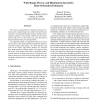Free Online Productivity Tools
i2Speak
i2Symbol
i2OCR
iTex2Img
iWeb2Print
iWeb2Shot
i2Type
iPdf2Split
iPdf2Merge
i2Bopomofo
i2Arabic
i2Style
i2Image
i2PDF
iLatex2Rtf
Sci2ools
FGR
2000
IEEE
2000
IEEE
Wide-Range, Person- and Illumination-Insensitive Head Orientation Estimation
We present an algorithm for estimation of head orientation, given cropped images of a subject’s head from any viewpoint. Our algorithm handles dramatic changes in illumination, applies to many people without per-user initialization, and covers a wider range (e.g., side and back) of head orientations than previous algorithms. The algorithm builds an ellipsoidal model of the head, where points on the model maintain probabilistic information about surface edge density. To collect data for each point on the model, edge-density features are extracted from hand-annotated training images and projected onto the model. Each model point learns a probability density function from the training observations. During pose estimation, features are extracted from input images; then, the maximum a posteriori pose is sought, given the current observation.
| Added | 31 Jul 2010 |
| Updated | 31 Jul 2010 |
| Type | Conference |
| Year | 2000 |
| Where | FGR |
| Authors | Ying Wu, Kentaro Toyama |
Comments (0)

